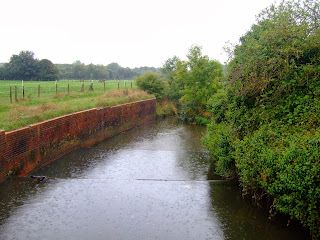This post is about the Frontal storm dubbed "Emily" which developed along a nasty weather system, with a wet/mild warm front moving in from the west and a thin yet nasty coldfront-low just behind. Both fronts had gained strength over the Atlantic ocean on the 17th December but the coldfront now had potential to turn into a Thin Lewp (line echo wave pattern) type storm.
During the 18th as the system drew ever closer wind speeds gradually picked up throughout the day, heading north towards the centre low. At this point the system was upgraded into an Atlantic Depression.
Towards the early evening the depression hit Ireland causing some localised flash flooding along some of its west coast. Here is a radar grab at around 17:30 with the warm front being the more obvious of the two, many forecasters didn't expect anything serious to happen.
Radar grab-18:30// 1hour later it travelled east into wales and caused Hundreds of homes to lose power when 70mph gusts disabled a large grid switching centre in Cheshire. At this point the storm suddenly increased strength and precipitation rates reached 70mm/hr.
Radar grab - 19:00// The warm front began to move north, and the coldfront had rapidly strengthened into a LineEchoWavePattern with the capability to produce misocyclone's and tornado's up to an F1.
By 19:30 The Warmfront had arrived the Hampshire county, Bringing moderate to heavy rain associated with strong southerly winds and violent gusts. To feel the full effect of the wind on the waves, I headed down to the overflowing Canoe lake in Southsea, Portsmouth.
Canoe Lake used to be connected to the sea as a Wetland known as the Great Morass until 1886 when it was blocked off by concrete embankments, today all that connects the sea to the Lake is a Tide suppressing Water Pipe. Wildlife here is restricted with small bait fish and shrimps making the majority of life in Canoe lake, also Shore crabs and More Recently Moon jellyfish populations have been discovered.
This was a rare occasion as Canoe lake is only marginally affected by the tide and precipitation runoff usually has little impact on the water volume here.
Nasty 50mph gusts Rocked the ancient large Oak tree's surrounding canoe lake.
With the Warmfront clearing off to the east, this left a 10minute gap inbetween the two fronts and taking the risk I headed to the derelict Old Portsmouth District to view the waves in full glory.
Photography is very tricky while being blasted by shingle, sea spray and 60mph winds!
Large Swell Waves Battered the sea defences even as it was Low Tide!
Brittany Ferries Mv Armorique Braves the odds on a rare winter service to st Marlo, France, Replacing the inadequate Mv Bretagne.
At this point the Cold front suddenly Arrived and wind speeds quickly picked up again, the sky's opened up to freezing cold rain which slowly forced me to retreat to shelter. Gusts of 64mph were recorded at this point as all hell broke lose.
I left Old Portsmouth shortly after (20:00), concerned for my safety and returned home.
Here Is a pressure chart, courtesy of the Met office taken at midnight.
The storm left flooding in the Bristol channel and several large rivers along the South coast. The gales killed two people in the north of the uk and cut power lines leaving thousands without electricity. The LEWP Spawned a Possible tornado over Whitehaven, Cumbria. And more severe weather has been forecasted in the weeks to come.






































































